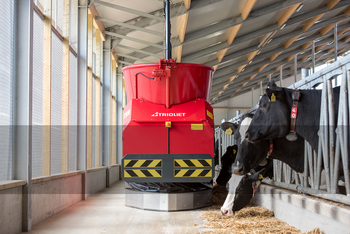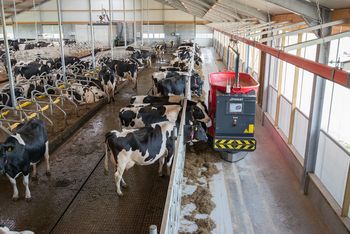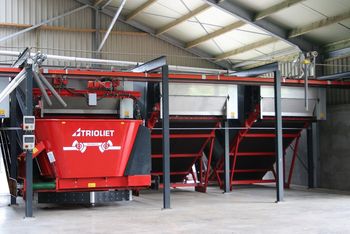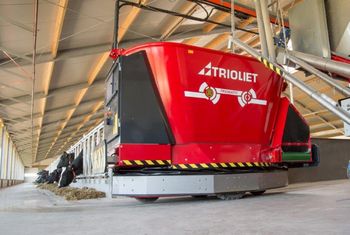Research among Triomatic users has shown that cost savings can result in as much as EUR 40,000. The savings come mainly from improved feed utilisation, higher milk production with better content, reduced labour and lower energy costs. However, it is not only the bottom line that looks better; the health of the cows also improves, as they are being fed multiple times per day.
More frequent feeding leads to a higher rate of forage conversion. Under optimal conditions, feed is always available at the gate, enabling the cow to eat whenever she wants. Using a Triomatic automatic feeding system, each feeding group can be fed up to twelve times a day. Moreover, when fresh feed is provided multiple times a day, a specific cow's feed conversion is no longer impacted by the hierarchy within the group.
More frequent feeding leads to higher forage conversion
More regular and structured feeding leads to better digestion and helps the cow's rumen function properly. The Triomatic's RPM can be specified per ration, allowing coarse rations to be properly mixed. Thanks to the mixing augers' high RPM, the forage does not need to be chopped.
Easily mix small rations
Cows are animals with a very fixed biological clock, which is why it is important to feed cows at fixed times, as past scientific studies have already shown. The ration also needs to be consistent, every day and every feed. The Triomatic has a loading precision of 1-2 kg per forage component. The two small vertical cutting augers in the feeding robot can prepare very small, homogeneous mixtures for smaller groups; the minimum quantity is approximately 60 kg.
It is essential for rations to be adapted to the cows' stages of life and lactation. Using the Triomatic, the calves can be fed in multiple groups. Lactating cows can be fed in various production groups if desired, and dry cows can be split into two or even three groups as well. During the dry period in particular, it is important for the cows to be prepared for lactation at the right time during the dry period in order to prevent lactation issues. This is why it is important to be able to feed smaller groups.
Feed efficiency
Thanks to the higher feeding frequency and the freshness of the feed, the cows are able to absorb more nutrients from the forage. This means the number of kilos of concentrate per 100 kg milk can be reduced accordingly. This generally leads to higher ration efficiency. On average, the feed efficiency in Western Europe is 1.2 to 1.3 (kg milk/kg DM). Triomatic customers have seen that the ration efficiency can rise to between 1.5 and 1.7. An increase in ration efficiency of 0.1 saves around EUR 150 per year in feed costs per LSU.
With this in mind, automated feeding is not just a question of saving time (average work time with the Triomatic is one hour per 100 LSU per week); it also has an impact on the cattle's health, milk production, feed costs and therefore the overall income of the dairy farm. Moreover, the Triomatic's energy consumption is approximately 0.1 kWh/LSU, i.e. 10 kWh per day for 100 LSU, which is less than EUR 2 per day.
The Triomatic is available in up to eight different configurations. There are three different feed kitchens and two different robots. Each one is easy to operate, requires little maintenance and only needs a single feed robot to be suitable for farms with 50 to 700 cows. Prices start at EUR 89,000.



